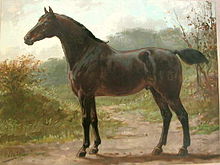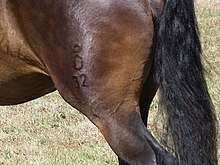
Trakehner is a light warmblood breed of horse, originally developed at the East Prussian state stud farm in the town of Trakehnen from which the breed takes its name. The state stud was established in 1731 and operated until 1944, when the fighting of World War II led to the annexing of East Prussia by Russia, and the town containing the stud renamed as Yasnaya Polyana.

Warmbloods are a group of middle-weight horse types and breeds primarily originating in Europe and registered with organizations that are characterized by open studbook policy, studbook selection, and the aim of breeding for equestrian sport. The term distinguishes these horses from both heavy draft horses and refined light saddle horses such as the Thoroughbred, Arabian, and Akhal-Teke. Although modern warmbloods are descended from heavier agricultural types systematically upgraded by hotblood influence, the term does not imply that warmbloods are direct crosses of "cold" and "hot".

The Groninger or Groningen is a Dutch horse breed developed for light draft and agricultural work. It is closely related to heavy warmblood breeds like the East Friesian and Alt-Oldenburger. The breed was nearly lost in the mid-20th century because a significant number of mares were used for crossbreeding to create the Dutch Warmblood, leaving few purebreds.

A Hanoverian is a Warmblood horse breed originating in Germany, which is often seen in the Olympic Games and other competitive English riding styles, and has won gold medals in all three equestrian Olympic competitions. It is one of the oldest, most numerous, and most successful of the Warmblood breeds. Originally a cavalry horse, infusions of more Thoroughbred blood lightened it to make it more agile and useful for competition. The Hanoverian is known for a good temperament, athleticism, beauty, and grace.
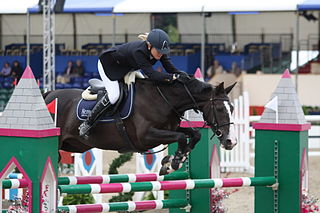
The Selle Français (SF) is a breed of sport horse from France. It is renowned primarily for its success in show jumping, but many have also been successful in dressage and eventing. An athletic horse with good gaits, it is usually bay or chestnut in color. The Selle Français was created in 1958 when several French riding horse breeds were merged into one stud book. The new breed was meant to serve as a unified sport horse during a period when horses were being replaced by mechanization and were transforming into an animal used mainly for sport and leisure.
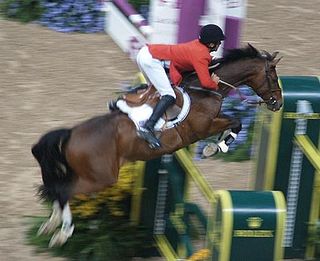
The Holsteiner is a breed of horse originating in the Schleswig-Holstein region of northern Germany. It is thought to be the oldest of warmblood breeds, tracing back to the 13th century. Though the population is not large, Holsteiners are a dominant force of international show jumping, and are found at the top levels of dressage, combined driving, show hunters, and eventing.
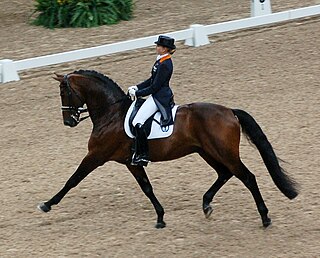
A Dutch Warmblood is a warmblood type of horse registered with the Koninklijk Warmbloed Paardenstamboek Nederland (Royal Warmblood Studbook of the Netherlands, which governs the breeding of competitive dressage and show jumping horses, as well as the show harness horse and Gelderlander, and a hunter studbook in North America. Developed through a breeding program that began in the 1960s, the Dutch are some of the most successful competition horses developed in postwar Europe.

The American Warmblood is a horse of warmblood type, intended primarily for the traditional sport horse disciplines of dressage, show jumping, eventing and combined driving.

The Belgian Warmblood or Belgisch Warmbloedpaard is a Belgian breed of warmblood sport horse. It is bred for dressage, for show-jumping and for three-day eventing. It is one of three Belgian warmblood breeds or stud-books, the others being the Zangersheide and the Belgian Sport Horse – to which it is quite similar.

The Westphalian or Westfalen is a warmblood horse bred in the Westphalia region of western Germany. The Westphalian is closely affiliated with the state-owned stud farm of Warendorf, which it shares with the Rhinelander. Since World War II, the Westphalian horse has been bred to the same standard as the other German warmbloods, and they are particularly famous as Olympic-level show jumpers and dressage horses. Next to the Hanoverian, the Westphalian studbook has the largest breeding population of any warmblood in Germany.

The Bavarian Warmblood is a horse breed of southern Germany that developed from an older Bavarian heavy warmblood breed called the Rottaler. Since mechanization in the mid-20th century, the Bavarian Regional Horse Breeders' Society has concentrated on producing a riding horse for the Olympic disciplines and recreational riding based on other European warmblood bloodlines.
An Austrian Warmblood is a warmblood type of horse registered with the Arbeitsgemeinschaft für Warmblutzucht in Österreich. Although the studbook is made up of jumping and dressage horses from many other countries, the mare base consists of native horses with a long history. The AWÖ keeps an open studbook, in which mares and stallions must pass rigorous inspections before becoming breeding stock.

The heavy warmbloods are a group of horse breeds primarily from continental Europe. The title includes the Ostfriesen and Alt-Oldenburger ("Old-Oldenburger"), Groningen, and similar horses from Silesia, Saxony-Thuringia, and Bavaria. Breeds like the Hungarian Nonius, Kladruber, and Cleveland Bay are also often classed as "heavy warmbloods." They are the ancestors of the modern warmbloods, and are typically bred by preservation groups to fit the pre-World War I model of the all-purpose utility horse. Unlike the registries of the sport horses that followed them, many heavy warmblood registries maintain closed or partly closed studbooks. However, external evaluation and performance testing of the breeding stock is still a key element in these registries. Many of the heavy warmbloods are selected primarily for family-friendly temperaments.

The Alt-Oldenburger and Ostfriesen are representatives of a group of horse breeds primarily from continental Europe called heavy warmbloods. The breed has two names because the same horse was bred in two regions in the most north-western part of Germany: East Frisia and the former grand duchy of Oldenburg. The name "Alt-Oldenburger" - alt meaning "old" - simply distinguishes this horse from its descendant, the modern Oldenburg, which is bred for sport.

The Rhenish Warmblood, German: Rheinisches Warmblut or Rheinisches Reitpferd, is a German warmblood breed of sport horse. It was registered with the Rheinisches Pferdestammbuch until 2014, when the Hannoveraner Verband took over management of the stud-book. It is traditionally bred around Warendorf State Stud, which it shares with the Westphalian, and is bred to the same standard as the Westphalian and other German warmbloods, such as the Bavarian Warmblood, Mecklenburger, Brandenburger, and Württemberger.

The Zweibrücker is a type of German warmblood horse bred in Rhineland-Palatinate and Saarland. Traditionally, the breeding of Zweibrücken was centered on the onetime Principal Stud of Zweibrücken but since 1977 has been under the jurisdiction of the Horse Breeders' Association of Rhineland-Palatinate-Saar (PRPS). The modern Zweibrücker is an elegant, large-framed, correct sport horse with powerful, elastic gaits suitable for dressage, show jumping, eventing and combined driving.
German warmblood may refer generally to any of the various warmblood horses of Germany, or more specifically to a warmblood registered with the nationwide German Horse Breeding Society. Beneath the umbrella term German warmblood are several regional variations on a singular standard; individual German warmblood types are not necessarily considered "breeds", because they have an open stud book and freely exchange genetic material between each other, with other warmblood types, with Anglo-Arabians, and with breeds like the Thoroughbred, Arabian, and Trakehner. All horses that are warmbloods and bred in Germany are named after the region in which they are born in. There is an exception to this and that is the Trakehner breed.
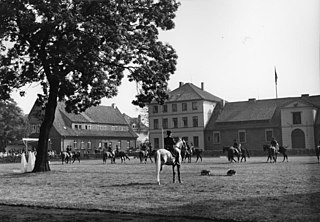
Celle State Stud is a state-owned facility for horse breeding in Celle, Germany. The State Stud of Celle, located in what is now known as Lower Saxony, was founded in 1735 by order of George II, King of Great Britain, Elector of Hanover and Duke of Brunswick-Lüneburg. Its purpose was to make high-quality stallions available to local breeders. Several wars affected not only the safety of the horses, but the types of stallions housed there. Celle's history is intertwined with the history of the Hanoverian horse breed, but the breed registry is privately owned and is an entity independent of the stud. Today the state stud is known for its annual stallion parades.
Rafalca is a former dressage horse, co-owned by Ann Romney, that performed in the equestrian competition at the 2012 Summer Olympics, with rider Jan Ebeling. She was retired from competitions in 2014, and is now a broodmare.

The British Warmblood is a breed registry of sport horses created in the UK in 1977 by the British Warmblood Society, with open registration. It comprises a base of European sport horses including Hanoverians, Dutch Warmbloods and Danish Warmbloods. The studbook was officially recognized in 1994, and became widely adopted by British breeders in the 2000s.


